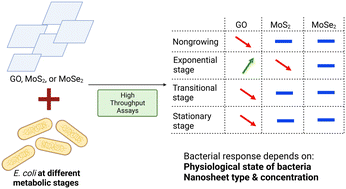Effect of bacterial growth stage on the response to two-dimensional nanomaterials†
Abstract
Bacterial growth stage plays an important role in how bacteria interact with nanoparticles, but the effect that two-dimensional nanomaterials may have on this interaction has yet to be rigorously studied. The goal of this study is to explore the role of the growth stage (non-growing, exponential, transitional, and stationary) of Escherichia coli (E. coli) in its response to graphene oxide (GO), MoS2, and MoSe2 colloidal nanosheets (ranging 0.00–2.52 μg GO–TOC, MoS2–Mo, or MoSe2–Mo mL−1). This study is the first to comprehensively examine the response of E. coli at its various growth stages to two-dimensional nanomaterials. We also examine bacterial response to novel two-dimensional nanomaterials (MoS2 and MoSe2) compared to an extensively studied material (GO). The bacterial responses were quantified in terms of respiration and growth rate and membrane permeability. A novel, high throughput technique was applied to rapidly reveal the range of biological responses that occurred. E. coli response to nanosheet exposure was dependent on the concentration and type of nanomaterial, and the bacterial growth stage. GO at 2.27 μg GO–TOC mL−1 led to a 17% reduction in respiration rate. Reductions in growth rate for this condition during the transitional and stationary stages were 9% and 87% respectively, compared to the 0.00 μg GO–TOC mL−1 control condition growth rate. When rapidly growing E. coli in a nutrient-rich environment is exposed to GO, the growth rate increased (up to 22% for the 2.27 μg GO–TOC mL−1 sample). Under these conditions, E. coli can use GO as a scaffold for cellular growth, leading to an increase in growth rate. MoS2 and MoSe2 have little impact on the growth and respiration of E. coli regardless of the environment. The membrane permeability assay shows that the Mo nanosheets lead to a greater increase in membrane permeability in E. coli compared to GO. Our characterization of the Mo materials shows that they are smaller and stiffer compared to GO, so they are more likely to puncture the membrane. This study demonstrates that microorganisms have a range of responses to nanosheets and that the physiological condition of the bacteria and the nanosheet type play important roles in their response.



 Please wait while we load your content...
Please wait while we load your content...